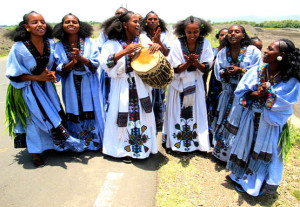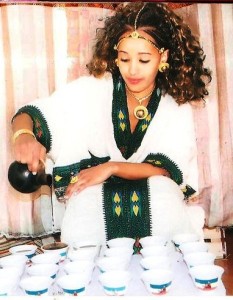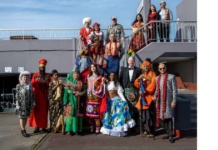The Tigray (Tigrigna) people are related to the Amhara and Tigre people of Ethiopia and Eritrea who together make up the Habeshans. These people can trace their origins back to Shem, eldest son of Noah. They left present day Yemen and settled on the African side of the Red Sea inhabiting the Nile Delta and all land East of the valley down to the Ethiopian Highlands. These people are known in antiquity as the Ancient Egyptians who retreated back to Ethiopia and Eritrea after countless takeovers of Egypt. Here they established other great kingdoms such as Sheba/Saba and Axum. After the Middle Ages they soon split into 3 tribes: Amhara, Tigre and Tigray with their own languages that all derived from Ge’ez, their ancient language.
After a mass migration from Egypt, the Habeshans settled in the Ethiopian Highlands and Red Sea coast of present day Eritrea and North-Eastern Sudan. The Tigray live primarily in the Northern Highland of Ethiopia and the Southern plateau in Eritrea.
The lives of the Tigray are much like the Highland Amharas. They are mainly farmers and pastoralists. In older times there were several large urban communities in the Tigray Region that flourished and created much Christian art in the Abyssinian middle ages.
From early encounters with the Hebrew people, many Habeshans adopted the early form of proto-Judasim. Though the high and ruling class continued to to practice the Egyptian pagan religion until Queen Makda of Sheba was converted by King Solomon to Judaism. Christianity came to the Tigray through Coptic missionaries. The Tigray and other Habeshans were the first African converts to Islam after sheltering Muhammad’s followers in the holy city of Negash, located in the Tigray Region, from their enemies in Mecca. The converted Habeshans (especially Tigray Muslims) became known as the Jeberti (Elect of God). They became the religious leaders and university teachers in the powerful Islamic city of Zeila in NW Somalia. Because of the Islamic expansion, Aksum was cut from other Christian kingdoms which created their own unique form of Coptic Christianity by incorporating Judaistic rituals and laws and putting a large focus on monasticism. today the majority of Tigray people are Ethiopian Orthodox and the minority are Sunni/Sufi Muslim.
Culture
Ashenda is a unique Tigraian traditional festival which takes place in August to mark the ending of fasting called filseta. This event is mostly for girls and young women, which they await very eagerly every year. It is unique to the people in the state of Tigrai in northern Ethiopia. The name of the festival “Ashenda” comes from the name of a tall grass that the girls make in to a skirt and ware it around their waist as a decoration.
The young women and girls dress the best traditional dresses called tilfi which is a cotton dress decorated with amazing embroidery from the neck to toe in front of the dress. The girls also adorned themselves with array of beautiful jewelry.
After they gather in the village or city center they divide in to small groups and they go house to house singing and playing their drums. They stop at ever house and sing and dance for the people in the houses. It is customary for people to give them money, food and drinks and other items for their efforts. They continue the whole day going from house to house and occasionally stopping in a village or city center and singing and dancing for a while before they go on again on their tour.
A week or so after the celebrations started, the event comes to an end with all the girls from the village or the town coming together in the center of the town or a village singing and dancing until sun down. This time the young boys join in more like spectators than active players.
The women of Tigrai are known for their beauty in Ethiopia. Women in Tigrai might ware Variety of hairstyles based on their age and marital status. Young girls shave their hair on the side of their head leaving some hair at the back of the head and around the head. The shaved part slowly closes over the years, by the time a young lady is married and have a kid she officially enters womanhood and she wears the fully braided hair do. There are many styles of braiding from the very fine called gilbich to a course one called albaso. All the hairdo styles show the most amazing artistic skills of the people developed for ages.
The Tigrai women hair style is unique to the people of Tigrai. It takes long time to do the fine hair braids and it is not done by anybody, there are women who specialize in the skill and that is what they do for a living. When it is done it looks like an art more than hair style. The jewelry that is worn by Tigrai women is also very unique to the region it is usually made mainly of gold and silver and sometimes copper.
Coffee is a very important ceremonial drink in Tigrai. The coffee ceremony is common through out the state and most of Ethiopia. Fresh beans are roasted; while they are hot and smoking they are passed around by the coffee maker usually a girl for blessing. The roasted beans are ground and served in very small richly decorated ceramic cups. The coffee is served in three rounds. The first round is called Awell, the second Bereka and the third Dereja. It is customary to show you appreciation by telling the person who is making and serving the coffee how good the coffee is.
As many people around the globe Tigrai people have long used face scarification for the expression of cultural identity. When a baby is about two to six year old a traditional doctor will cut two very small incisions on the temple of the kid. Sometimes these cuts can be on the eye brows and if they are done properly the scars will be very thin and hardly noticeable. Usually the scars would be less than one eighth an inch wide and about quarter an inch tall. If the cuts are done by the parent or unskilled person they can leave bigger scars.
In Ethiopia only the Tigrai people do mark their faces with these small straight line incisions side by side on their face. In the past 90 years since the Tigraians lost power to the Amhara people of central Ethiopia, their tradition, language and cultural practices have been attacked and ridiculed. The facial scars of the people of Tigrai have been source of insult and discrimination by the Amhara who tried to destroy the Tigrai identity. Despite the humiliation the practice still continues today in Tigrai, in fact most young people are finding their own cultural identity and embracing it with pride.










